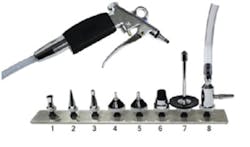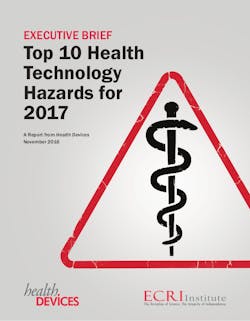Appropriate air for drying scopes; reprocessing hazards still rate high
Submit your questions
email: [email protected]
phone: (941) 927-9345 ext. 202
Q We are planning to take over the responsibility for the reprocessing of flexible endoscopes and are doing some redesign and renovations to have an appropriate work area for this new task. We currently have medical air at our instrument drying station and was told it would be cost prohibitive to extend the medical airline to the new flexible scope drying station. Would it be acceptable to use medical-grade air from a portable tank? If that would work, would I need to have a regulator for the tank connection? What type of hose or nozzle would be required?
A Instrument air should be utilized to dry medical devices including endoscopes, not medical air. Medical-grade air is prescribed by a physician for use in patient care. Also, per the national fire protection agency (NFPA), medical-grade air should not be used in medical device cleaning processes.
AAMI standard ST91Flexible and semi-rigid endoscope processing in health care facilities is currently undergoing review and revisions and it is anticipated that the use of instrument air will be addressed in the revised document. Tanks of instrument air are available and would be acceptable for use in drying channels and lumens of medical devices such as endoscopes. A regulator should be utilized to ensure pressure does not exceed that which is recommended by the endoscope manufacturer’s IFU. Excessive pressure could damage the endoscope resulting in a performance malfunction, which could put the patient at risk. Air guns, hoses and adaptors intended for such use are readily available (see figure 1).
Q I was recently at a conference and the speaker was talking about medical equipment and processing hazards that exist in hospitals. She kept referring to some list that rated these hazards. Who are these people and where do they get their information to support such harsh accusations about processing and other so-called technical risks?
A I am not 100 percent sure of what you or the speaker are referring to specifically. However, I believe it might be an annual report published by ECRI Institute which identifies the Top 10 Health Technology Hazards annually. ECRI was founded more than 50 years ago and is a highly recognized and regarded nonprofit, independent institution. ECRI staff consists of engineers, scientists, clinicians, and other patient safety analysts. ECRI’s rigid conflict-of-interest rules have been carefully developed to create an environment that maximizes objectivity, productivity, and integrity of process. ECRI accepts no advertising or revenues from any source. Employees are not permitted to own stock shares in medical device or pharmaceutical firms, which verified by examining each employee’s federal income tax return. They go beyond the industry norm to ensure that we receive unbiased guidance.
All of their studies and findings are based on sound scientific data and research, and all outcomes are evidence-based. The process is very intense and thorough and includes investigating incidents, testing medical devices, observing operations and assessing hospital practices, reviewing the literature, speaking with clinicians, clinical engineers, technology managers, purchasing staff, health systems administrators, and device suppliers. During this process, numerous technology risks — well beyond 10 — are identified. The long list is presented to a team of professionals from ECRI Institute’s many program areas, as well as an external advisory council which diligently reviews each technology hazard presented before selecting their top 10 hazards. ECRI uses this feedback to produce the final list, weighing factors such as:
- Severity. What is the likelihood that the hazard could cause serious injury or death?
- Frequency. How likely is the hazard? Does it occur often?
- Breadth. If the hazard occurs, are the consequences likely to spread to affect a great number of people, either within one facility or across many facilities?
- Insidiousness. Is the problem difficult to recognize? Could the problem lead to a cascade of downstream errors before it is identified or corrected?
- Profile. Is the hazard likely to receive significant publicity? Has it been reported in the media, and is an affected hospital likely to receive negative attention? Has the hazard become a focus of regulatory bodies or accrediting agencies?
- Preventability. Can actions be taken now to prevent the problem or at least minimize the risks? Would raising awareness of the hazard help reduce future occurrences?
The 2017 list includes:
- Infusion Errors Can Be Deadly If Simple Safety Steps Are Overlooked
- Inadequate Cleaning of Complex Reusable Instruments Can Lead to Infections
- Missed Ventilator Alarms Can Lead to Patient Harm
- Undetected Opioid-Induced Respiratory Depression
- Infection Risks with Heater-Cooler Devices Used in Cardiothoracic Surgery
- Software Management Gaps Put Patients, and Patient Data, at Risk
- Occupational Radiation Hazards in Hybrid ORs
- Automated Dispensing Cabinet Setup and Use Errors May Cause Medication Mishaps
- Surgical Stapler Misuse and Malfunctions
- Device Failures Caused by Cleaning Products and Practices
Items on the Top 10 List of Health Technology Hazards are not just randomly selected, but must earn their place on the list.
Two items directly related to Sterile processing make it to the list repeatedly:
- Inadequate Cleaning of Complex Reusable Instruments Can Lead to Infections
- Device Failures Caused by Cleaning Products and Practices
It is important to note that the identified risks and hazards on the list do not necessarily apply to all healthcare facilities. Nonetheless, all healthcare professionals should heed these warnings and carefully examine their operations to ensure that they are following and enforcing the best standards of practice and have an effective quality assurance program in place.
About the Author

Ray Taurasi
Ray Taurasi is Principal, Healthcare CS Solutions. His healthcare career spans over five decades as an Administrator, Educator, Technologist and Consultant. He is a member of AORN, SGNA, AAMI and a past president of IAHCSMM. Taurasi has been a faculty member of numerous colleges teaching in the divisions of business administration, nursing, and health sciences. He is the author of numerous articles and textbook chapters; he is a frequent speaker at national and international healthcare conferences.
Note to readers from Ray Taurasi - In 2021, my life’s career path will transition to one of new opportunities and adventures. As a result, after nearly 19 years and 225 CS Solution columns, this edition will be my last.
“All changes, even the most longed for, have their melancholy; for what we leave behind us is a part of ourselves; we must die to one life before we can enter another.”– Anatole France
I wish you and your loved ones a healthy and joyful holiday season and a beautiful New Year! God Speed, Ray
https://www.facebook.com/pages/category/ Local-Business/Healthcare-CS-Solutions-128857 3061153887/ • email: [email protected]


